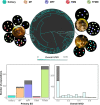Primate social organization evolved from a flexible pair-living ancestor
- PMID: 38154063
- PMCID: PMC10769843
- DOI: 10.1073/pnas.2215401120
Primate social organization evolved from a flexible pair-living ancestor
Abstract
Explaining the evolution of primate social organization has been fundamental to understand human sociality and social evolution more broadly. It has often been suggested that the ancestor of all primates was solitary and that other forms of social organization evolved later, with transitions being driven by various life history traits and ecological factors. However, recent research showed that many understudied primate species previously assumed to be solitary actually live in pairs, and intraspecific variation in social organization is common. We built a detailed database from primary field studies quantifying the number of social units expressing different social organizations in each population. We used Bayesian phylogenetic models to infer the probability of each social organization, conditional on several socioecological and life history predictors. Here, we show that when intraspecific variation is accounted for, the ancestral social organization of primates was inferred to be variable, with the most common social organization being pair-living but with approximately 10 to 20% of social units of the ancestral population deviating from this pattern by being solitary living. Body size and activity patterns had large effects on transitions between types of social organizations. As in other mammalian clades, pair-living is closely linked to small body size and likely more common in ancestral species. Our results challenge the assumption that ancestral primates were solitary and that pair-living evolved afterward emphasizing the importance of focusing on field data and accounting for intraspecific variation, providing a flexible statistical framework for doing so.
Keywords: monogamy; social structure; social system.
Conflict of interest statement
Competing interests statement:The authors declare no competing interest.
Figures



References
-
- Shultz S., Opie C., Atkinson Q. D., Stepwise evolution of stable sociality in primates. Nature 479, 219–222 (2011). - PubMed
-
- Silcox M. T., Bloch J. I., Boyer D. M., Chester S. G. B., López-Torres S., The evolutionary radiation of plesiadapiforms. Evol. Anthropol. 26, 74–94 (2017). - PubMed
-
- Dagosto M., Gebo D., Ni X., Smith T., Estimating body size in early primates: The case of Archicebus and Teilhardina. J. Hum. Evol. 115, 8–19 (2018). - PubMed
MeSH terms
LinkOut - more resources
Full Text Sources
Research Materials

